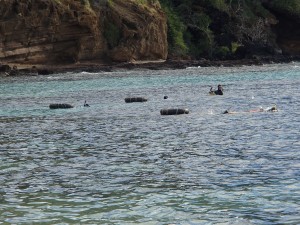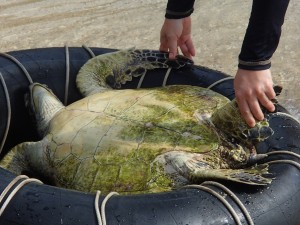
Today in class we frolicked with seven fat and happy sea turtles in contribution to a long-term health assessment of Hawaii green turtles, or “honu” in Hawaiian. Andy set up the day’s adventures essentially on my behalf – what a great professor. These beautiful juvenile green turtles live for munching on various algae growing on the coral reefs of Hanauma Bay. Hanauma Bay Nature Preserve is the first Marine Life Conservation District for the State of Hawaii and is therefore undeniably beautiful. The bay is managed by the City and County of Honolulu, who have put measures in place to limit the impact tourists have on the bay. The educational center is the source of marine conservation education for millions who visit Hanauma Bay annually. Luckily for us, the bay is closed to tourists every Tuesday in order to allow the reef a breather from the constant onslaught of snorkelers. Thus, it was a perfect day for some science.
We worked under the guidance of the NOAA Pacific Islands Fisheries Science Center’s Marine Turtle Assessment Program team leader, Dr. Kyle Van Houtan. Kyle and his team were fantastic hosts. In fact, not to digress, but everyone we have met so far on O’ahu has been noticeably smiley and kind. I wager that the topical paradise lifestyle has something to do with that. One such cheerful character, and world renowned sea turtle biologist, is Dr. George Balazs. George entertained those on land with endless sea turtle stories and jokes while Kyle allowed me to tag along with him out in the water. Kenady (our fearless TA) and I were the brave souls who eagerly volunteered to go in the water to help wrangle up as many sea turtles as we could find. Do not fear, given we were working with NOAA all necessary Endangered Species Act permits were in hand in order to handle the turtles.



Essentially the process worked like this:
There were six of us in the water and fifteen or so on land. The snorkelers paired up into three teams. Each pair had one professional (Kyle, in my case) and one strong swimmer/overly enthusiastic grad student (me). The swimmer was given an inner-tube affixed to a wooden board – this was the device used to transport the turtle from wherever we found it back up to the shore. Once Kyle spotted a turtle, we would swim calmly beside it for a few minutes to show it we meant no harm. Once the turtle came up to the surface near us, the wrangling began. Kyle firmly grasped the carapace (top shell) of the turtle and gained control while I swam over and allowed him to place the turtle in the inner-tube. Once we transferred hold of the turtle from him to me, I would steadily swim back to shore, turtle in tow. Once we both arrived to shore, I’d take a breather while the land-folks took over and prepped each turtle for its health assessment. For me, it was dive back in and repeat the turtle whispering.



On land, the rest of the class was busy helping with the health assessment. This entailed several measurements, inserting pit tags in the hind flippers, and checking the mouth for food or tumors. Let’s talk tumors. One of the main driving forces behind his health assessment is to check the status of a tumor-forming virus called fibropapillomatosis. The jury is still out on the cause of this herpes-like virus but it is plaguing sea turtles worldwide by causing cauliflower-like tumors all over their bodies. Thankfully, yet uncommonly, none of the turtles we caught today suffered from fibropapillomatosis. They all appeared healthy and happy. Before we knew it, all seven turtles’ physicals were complete and they were released back into Hanauma Bay where they will hopefully live long lives.



We topped the morning off with lunch at Kona Brewing Company. Facing the water with a slice of pizza, greek salad, and a Wailua Ale, after having just frolicked with green sea turtles on a perfect beach, the rest of the day had some big shoes to fill. I’d say expectations were met after an afternoon snorkeling with the SUPER SUCKER. That was my shameless plug for my pal Lydia’s blog post. Read on!
